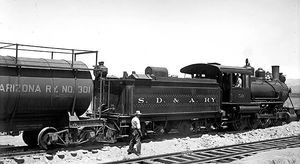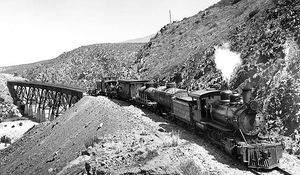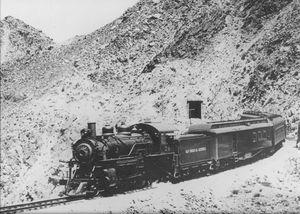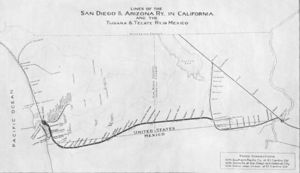San Diego and Arizona Railway/Gallery: Difference between revisions
Jump to navigation
Jump to search

imported>Robert A. Estremo m (format) |
imported>Robert A. Estremo m (add image) |
||
| Line 1: | Line 1: | ||
{{subpages}} | {{subpages}} | ||
<gallery perrow= | <gallery perrow=3 widths=300px heights=250px> | ||
Image:John D. Spreckels 1901.jpg|{{John D. Spreckels 1901.jpg/credit}}<br />John Diedrich Spreckels, "The Great Builder," in 1901. | Image:John D. Spreckels 1901.jpg|{{John D. Spreckels 1901.jpg/credit}}<br />John Diedrich Spreckels, "The Great Builder," in 1901. | ||
Image:SD Union December 14 1906.jpg|{{SD Union December 14 1906.jpg/credit}}<br />The front page of the December 14, 1906 edition of the ''San Diego Union'' proclaims, "''RAILROAD FROM SAN DIEGO TO YUMA IS NOW ASSURED.''" | Image:SD Union December 14 1906.jpg|{{SD Union December 14 1906.jpg/credit}}<br />The front page of the December 14, 1906 edition of the ''San Diego Union'' proclaims, "''RAILROAD FROM SAN DIEGO TO YUMA IS NOW ASSURED.''" | ||
| Line 9: | Line 9: | ||
Image:SDA tunnel 4 east.jpg|{{SDA tunnel 4 east.jpg/credit}}<br />Looking into the United States through Tunnel #4, 598 feet long. | Image:SDA tunnel 4 east.jpg|{{SDA tunnel 4 east.jpg/credit}}<br />Looking into the United States through Tunnel #4, 598 feet long. | ||
Image:SD&A gas motor No 41.jpg|{{SD&A gas motor No 41.jpg/credit}}<br />SD&A gasoline-electric motor car No. 41, one of three similar self-propelled units used on commuter runs to La Mesa and Lakeside until they were retired in 1934. | Image:SD&A gas motor No 41.jpg|{{SD&A gas motor No 41.jpg/credit}}<br />SD&A gasoline-electric motor car No. 41, one of three similar self-propelled units used on commuter runs to La Mesa and Lakeside until they were retired in 1934. | ||
Image:Carriso Gorge trestle circa 1919.jpg|{{Carriso Gorge trestle circa 1919.jpg/credit}}<br />The massive wooden trestle under construction at Carriso Gorge, ''circa'' 1916. | |||
Image:Campo Creek Viaduct October 5 1919.jpg|{{Campo Creek Viaduct October 5 1919.jpg/credit}}<br />The upper Campo Creek Viaduct, "''...surely the most photographed bridge [on the SD&A]...''" is nearly 600 feet (183 meters) long.<ref>Hanft, pp. 200-201</ref> The steel structure was completed on October 5, 1919. | Image:Campo Creek Viaduct October 5 1919.jpg|{{Campo Creek Viaduct October 5 1919.jpg/credit}}<br />The upper Campo Creek Viaduct, "''...surely the most photographed bridge [on the SD&A]...''" is nearly 600 feet (183 meters) long.<ref>Hanft, pp. 200-201</ref> The steel structure was completed on October 5, 1919. | ||
Image:SDA engine 50.jpg|{{SDA engine 50.jpg/credit}}<br />Locomotive No. 50 of the San Diego and Arizona Rail line stands at a siding. | Image:SDA engine 50.jpg|{{SDA engine 50.jpg/credit}}<br />Locomotive No. 50 of the San Diego and Arizona Rail line stands at a siding. | ||
Revision as of 22:13, 4 August 2013
(PD) Photo: Unknown
Frank Forward, Sr. (mayor of San Diego) turns the first shovelful of dirt to ceremonially commence construction of the San Diego and Arizona Railway on September 7, 1907. At left is Frank Kimball, a prominent local landowner and rancher,[1] and to the right is real estate developer Alonzo Horton.(PD) Photo: Unknown
The upper Campo Creek Viaduct, "...surely the most photographed bridge [on the SD&A]..." is nearly 600 feet (183 meters) long.[2] The steel structure was completed on October 5, 1919.
Notes and references
- ↑ Kimball also represented the Chamber of Commerce and the Board of City Trustees of San Diego, and helped organize the Atchison, Topeka and Santa Fe Railway's subsidiary line the California Southern Railroad.
- ↑ Hanft, pp. 200-201
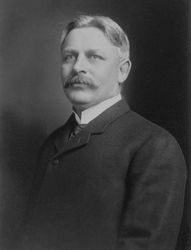
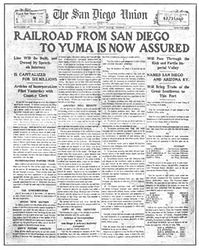
![(PD) Photo: Unknown Frank Forward, Sr. (mayor of San Diego) turns the first shovelful of dirt to ceremonially commence construction of the San Diego and Arizona Railway on September 7, 1907. At left is Frank Kimball, a prominent local landowner and rancher,[1] and to the right is real estate developer Alonzo Horton.](/wiki/images/thumb/2/27/SDandA_groundbreaking_on_September_7%2C_1907.jpg/267px-SDandA_groundbreaking_on_September_7%2C_1907.jpg)
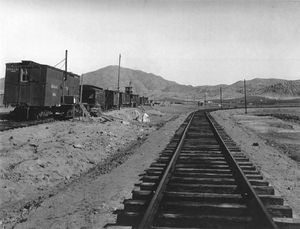
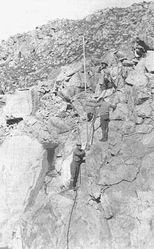
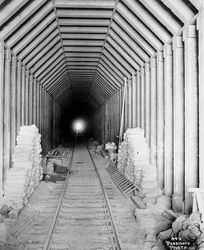
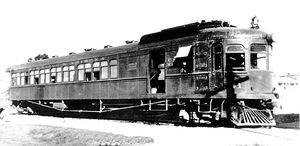
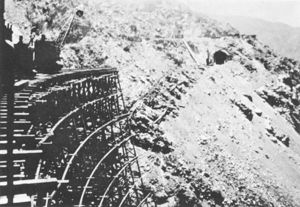
![(PD) Photo: Unknown The upper Campo Creek Viaduct, "...surely the most photographed bridge [on the SD&A]..." is nearly 600 feet (183 meters) long.[2] The steel structure was completed on October 5, 1919.](/wiki/images/thumb/0/0e/Campo_Creek_Viaduct_October_5_1919.jpg/300px-Campo_Creek_Viaduct_October_5_1919.jpg)
